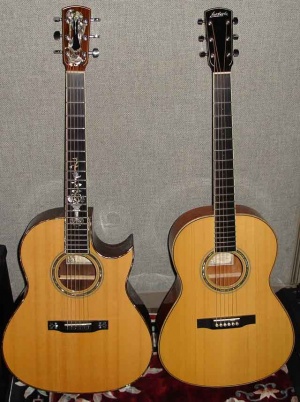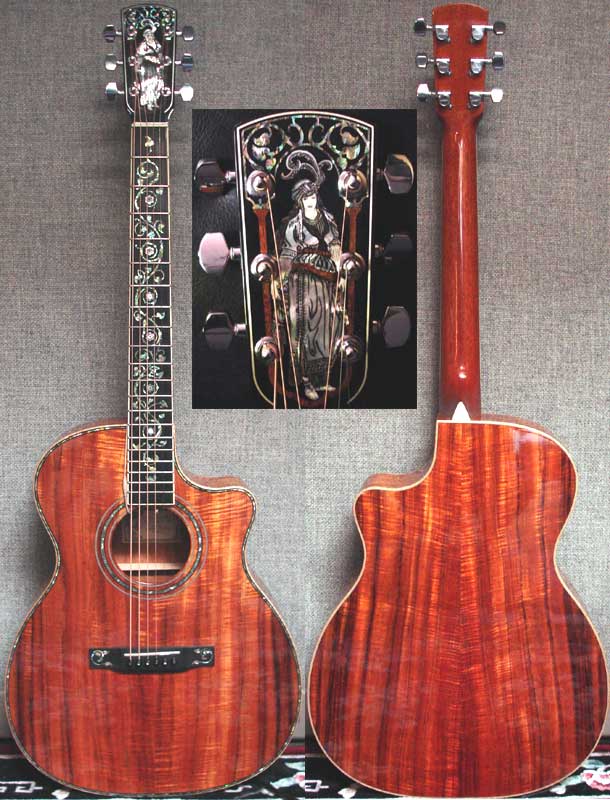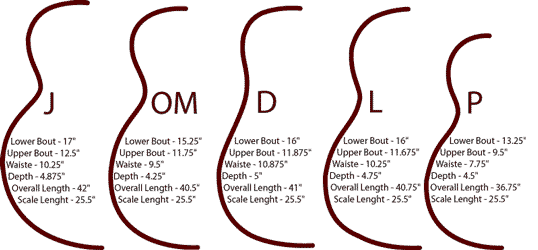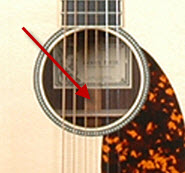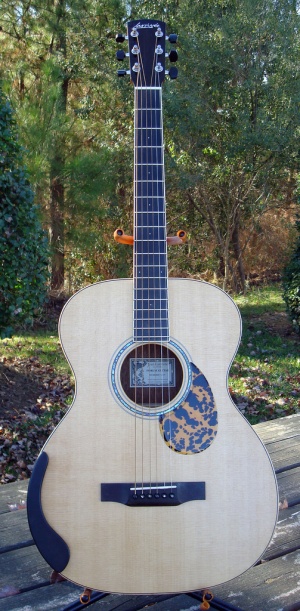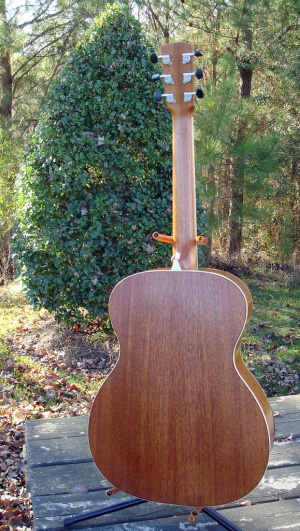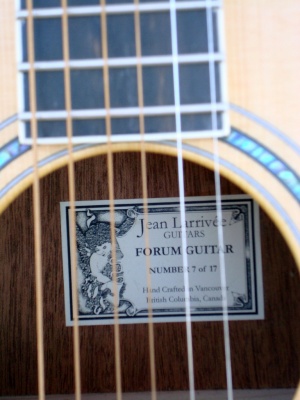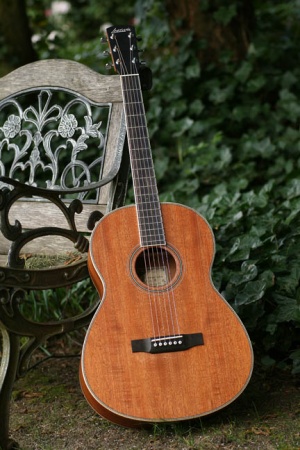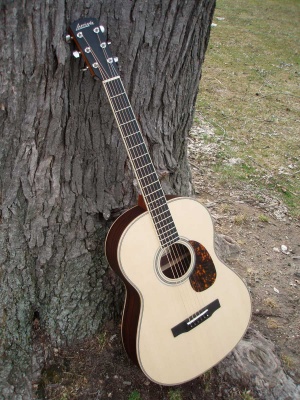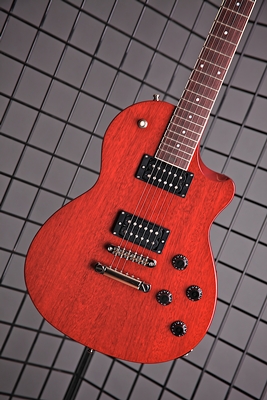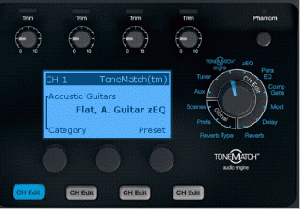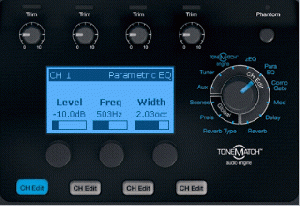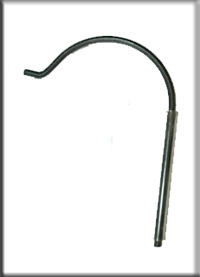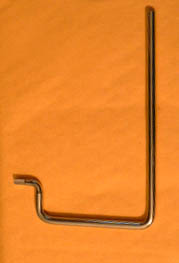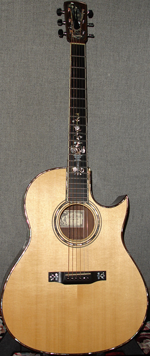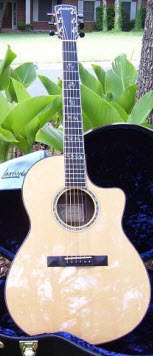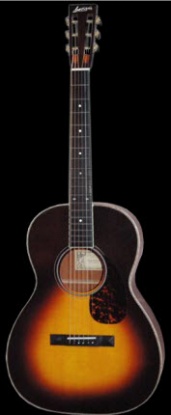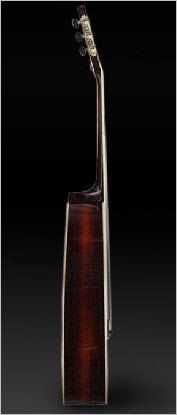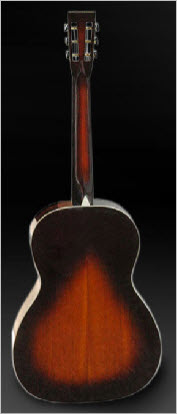Larrivée Guitars
Models
2012 45th Anniversary Model
2012 will mark Jean Larrivée's 45th year of building guitars. In doing so, the Larrivée Family is proud to announce the limited release of our 45th Anniversary Guitar. The LV-10 has been chosen to represent this limited edition with spectacularly figured Indian Silverwood bound with Indian Rosewood and abalone purfling. This Silverwood was discovered and hand selected by Jean last fall while searching for new exotic wood sources in India. The B.C. Sitka spruce soundboards are from Jean's private reserve, only to be used on such deserving limited runs. A lightweight genuine South American mahogany neck will feature a striking early 1900's style "Torch" headstock inlay designed by Wendy Larrivée for this notable occasion. A matching fretboard and bridge inlay will compliment the "Torch" and set in only the finest African ebony available. Finally, to tie it all together, will be a very special 12th fret inlay proudly displaying the dates "1967-2012".
Each of the 45 limited guitars will come with it's own certificate of authenticity hand signed by Jean Larrivée. Order yours now while they are available as numbers are strictly limited to 45. MSRP on this piece will be $4500.00 with delivery beginning in March. A photo documentary will be posted to our website and Facebook page along with updates on Twitter.
Thank you for 45 years of support,
The Larrivée Family
Source: John M Larrivée January 19, 2012
Body Styles
Overview
More details below
B - Bass
- Lower Bout: 17"
- Upper Bout: 12.5"
- Waist: 10.75"
- Depth: 4.75"
- Scale Length: 34"
- Nut Width: 1 & 3/4" (44.3mm or 1.75")
- Length 20 5/8"
C - Larrivée Body with a Florentine Cutaway
- Lower Bout · 16”
- Upper Bout · 11.625”
- Waist · 10.25”
- Depth · 4.75”
- Overall Length · 40.75”
- Scale Length · 25.5”
- Nut Width: 1 & 3/4" (44.3mm or 1.75")
CS - Larrivée Small Body with a Florentine Cutaway
- Lower Bout · 15”
- Upper Bout · 11.875“
- Waist · 9.75”
- Depth · 4.25”
- Overall Length · 40.5”
- Scale Length · 25.5”
- Nut Width: 1 & 3/4" (44.3mm or 1.75")
D - Dreadnought
- Lower Bout · 16”
- Upper Bout · 11.875”
- Waist · 10.875”
- Depth · 5”
- Overall Length · 41”
- Scale Length · 25.5”
- Nut Width: 1 & 11/16"
J - Jumbo
- Lower Bout · 17"
- Upper Bout · 12.5"
- Waist · 10.75"
- Depth · 4.75" - 4.875"
- Scale Length · 25.5"
- Nut Width · 1 & 3/4" (44.3mm or 1.75")
- Scale Length · 25.5”
- Length · 20 5/8"
Larrivee Lancaster
L - Larrivée Body
- Lower Bout · 16”
- Upper Bout · 11.625”
- Waist · 10.25”
- Depth · 4.75”
- Overall Length · 40.75”
- Scale Length · 25.5”
- Nut Width: 1 & 3/4" (44.3mm or 1.75")
LJ-body or CJ-body
- Lower Bout: 17"
- Upper Bout: 12.5"
- Waist: 10.75"
- Depth: 4.75"
- Scale Length: 25.5"
- Nut Width: 1 & 3/4" (44.3mm or 1.75")
- Length 20 5/8"
LS - Larrivée Small Body
- Lower Bout · 15”
- Upper Bout · 11.875“ (11.25" measured on one)
- Waist · 9.75” (9.5" measured on one)
- Depth · 4.25” (3.75" at heel)
- Body Length - 19.75"
- Overall Length · 40.5”
- Scale Length · 25.5”
- Nut Width: 1 & 3/4" (44.3mm or 1.75")
LSV - Larrivée Small Body with a Venetian Cutaway
- Lower Bout · 15.125”
- Upper Bout · 11.375“
- Waist · 9.75”
- Depth · 4.125”
- Overall Length · ___ ”
- Scale Length · 24.75”
- Nut Width: 1 & 3/4" (44.3mm or 1.75")
- Fretboard Radious: 16-21" Compound
- Setup for Medium Gauge Strings
- Frets: Nickel Silver
- Frets Width: 2.5 mm (0.0985")
- Frets Height 1.0mm (0.0394")
- Gloss UV Finish Body & Neck
OM - Orchestra Model
- Lower Bout · 15.375”
- Upper Bout · 11.75”
- Waist · 9.625”
- Depth · 4.25”
- Overall Length · 40.5”
- Scale Length · 25.5”
- Nut Width: 1 & 3/4" (44.3mm or 1.75")
- Setup for Light Gauge Strings
- Frets: Nickel / Silver
- Fretboard Radius: 17" to 21" Compound
- Frets Width: 2.5 mm (0.0985")
- Frets Height: 1.0 mm (0.0394")
— source
OO Body
- Lower Bout: 14"
- Upper Bout: 10"
- Waist: 8.25"
- Depth: 4"
- Scale Length: 25.5",
- 12 fret to body
- Nut Width: 1 & 3/4" (44.3mm or 1.75")
- Body Length 19-1/8"
OOOO Body
- Lower Bout · 15.375”
- Upper Bout · 11.125”
- Waist · 9.375”
- Depth · 4.5”
- Overall Length · ???
- Scale Length · 25.5”
- Nut Width: 1 & 13/16"
- Fretboard Radius: 16" to 21" Compound
- Setup for medium gauge strings
- Frets Width: 2.5 mm (0.0985")
- Frets Height: 1.0 mm (0.0394")
Also: 12th-fret neck join — source
P - Parlor
- Lower Bout · 13.25”
- Upper Bout · 9.5“
- Waist · 7.75”
- Depth · 4.5”
- Overall Length · 36.75”
- Scale Length · 24”
SD - Slope Dreadnaught
- Lower Bout · 15”
- Upper Bout · 11.25“
- Waist · 10.5”
- Depth · 4.875”
- Overall Length · 40.5”
- Scale Length · 25.5”
Classical
- Lower Bout · 15”
- Upper Bout · 11.875“
- Waist · 9.75”
- Depth · 4.25”
- Overall Length · 40.5”
- Scale Length · 660 mm (approximately 26”)
- Nut Width: 2"
Example: Larrivée Classical Model 38
Current Model Comparisons
Source: Larrivée web site December 2009
Introduction from the Larrivée Site
- This page contains the information which allows you to quickly compare multiple
models. Remember that every guitar we manufacture is hand-built, which means that they specs are the guidelines we use, but that the final specification may vary slightly.
Series Details
Feature Comparison
|
FEATURE |
-03
|
-05
|
-09
|
-10
|
-19
|
-50
|
-60
|
SD-50
|
SD-60
|
-30
|
| All Solid Wood Construction |
•
|
•
|
•
|
•
|
•
|
•
|
•
|
•
|
•
|
•
|
| Symetrical X Bracing |
•
|
•
|
•
|
•
|
•
|
•
|
•
|
•
|
•
|
|
| Hand Fit Dove Dail Neck Join |
•
|
•
|
•
|
•
|
•
|
•
|
•
|
•
|
•
|
•
|
| Ebony Fingerboard |
•
|
•
|
•
|
•
|
•
|
•
|
•
|
•
|
•
|
•
|
| Ebony Bridge |
•
|
•
|
•
|
•
|
•
|
•
|
•
|
•
|
•
|
|
| Single Piece Mahogany Neck |
•
|
•
|
•
|
•
|
•
|
•
|
•
|
•
|
•
|
•
|
| Ivroid Fretboard Binding |
•
|
•
|
•
|
•
|
•
|
•
|
•
|
•
|
•
|
|
| Solid Wood Body Binding |
•
|
•
|
•
|
•
|
•
|
•
|
•
|
•
|
•
|
•
|
| Limited Lifetime Warranty |
•
|
•
|
•
|
•
|
•
|
•
|
•
|
•
|
•
|
•
|
| Abalone Rosette |
|
•
|
•
|
•
|
•
|
•
|
•
|
•
|
•
|
|
| Satin Finish Neck |
•
|
•
|
•
|
•
|
•
|
•
|
•
|
•
|
•
|
|
| Satin Finish Body |
•
|
|
|
|
|
|
|
|
|
|
| Transparent Pickguard |
•
|
|
|
|
|
|
|
|
|
•
|
| Exclusive Beveled Pickguard |
|
•
|
•
|
•
|
•
|
•
|
•
|
•
|
•
|
|
|
FEATURE |
-03
|
-05
|
-09
|
-10
|
-19
|
-50
|
-60
|
SD-50
|
SD-60
|
-30
|
| Gloss Finish Body |
|
•
|
•
|
•
|
•
|
•
|
•
|
•
|
•
|
•
|
| Mother of Pearl Logo |
|
•
|
•
|
•
|
|
•
|
•
|
•
|
•
|
|
| Microdot fretboard Markers |
|
•
|
•
|
|
|
|
|
|
|
|
| Abalone Soundboard Purfling |
|
|
|
•
|
|
|
|
|
|
|
| Deluxe Fretboard Inlays |
|
|
|
•
|
|
|
|
|
|
|
| Deluxe Bridge Wing Inlays |
|
|
|
•
|
•
|
|
|
|
|
|
| Vine Fretboard Inlays |
|
|
|
|
•
|
|
|
|
|
|
| Vine Headstock Inlays w/ Logo |
|
|
|
|
•
|
|
|
|
|
|
| Open Back Stainless Steel Tuners |
|
|
|
|
|
•
|
•
|
|
|
|
| Flat Top Headstock w/ Volute |
|
|
|
|
|
•
|
•
|
|
|
|
| Pearl Diamond Fretboard Inlays |
|
|
|
|
|
•
|
•
|
•
|
•
|
|
| Herringbone Soundboard Purfling |
|
|
|
|
|
•
|
•
|
•
|
•
|
|
| Stainless Steel Side Mounted Tuners |
|
|
|
|
|
|
|
•
|
•
|
|
| Slotted Headstock w/ Volute |
|
|
|
|
|
|
|
•
|
•
|
|
| Symetrical Fan Bracing |
|
|
|
|
|
|
|
|
|
•
|
| Rosewood Bridge |
|
|
|
|
|
|
|
|
|
•
|
| Ebony Fretboard Binding |
|
|
|
|
|
|
|
|
|
•
|
| Handmade Classical Tuners |
|
|
|
|
|
|
|
|
|
•
|
| Classical Slotted Headstock |
|
|
|
|
|
|
|
|
|
•
|
| Mosaic Rosette |
|
|
|
|
|
|
|
|
|
•
|
Nut Width Comparison
| Model |
1 & 11/16"
|
1 & 3/4"
|
1 & 7/8"
|
2"
|
| Dreadnoughts |
•
|
|||
| Larrivee Bodies (All Series 6-String) |
•
|
|||
| Orchestra Models (All Series 6-String) |
•
|
|||
| Parlors |
•
|
|||
| Slope Dreadnaughts |
•
|
|||
| All Twelve Strings |
•
|
|||
| Classical Guitars |
•
|
Older Model Comparisons
|
|
Parlor |
-02
Series |
-03
Series |
-04
Series |
-05
Series |
-09
Series |
-10
Series |
|
All
solid wood construction |
• |
• |
• |
• |
• |
• |
• |
|
Symmetrical
bracing |
• |
• |
• |
• |
• |
• |
• |
|
Hand-fit
dovetail neck joint |
• |
• |
• |
• |
• |
• |
• |
|
Ebony
fretboard & bridge |
• |
• |
• |
• |
• |
• |
• |
|
Single
piece mahogany neck |
• |
• |
• |
• |
• |
• |
• |
|
Transparent
pick guard |
• |
• |
• |
• |
• |
• |
• |
|
Composite
nut & saddle |
• |
• |
• |
• |
• |
• |
• |
|
Fretboard
binding |
• |
• |
• |
• |
• |
• |
• |
|
Limited
lifetime warranty |
• |
• |
• |
• |
• |
• |
• |
|
Satin
finish |
• |
• |
• |
|
|
|
|
|
Gloss
finish |
|
|
|
• |
• |
• |
• |
|
Wood
body binding |
|
|
|
|
• |
• |
• |
|
Inlaid
silver headstock border |
|
|
|
|
• |
• |
• |
|
Pearl
Larrivee headstock logo |
|
|
|
|
• |
• |
• |
|
Abalone
rosette |
|
|
|
|
• |
• |
• |
|
Deluxe
fretboard inlay |
|
|
|
|
|
|
• |
|
Abalone
purfling around top |
|
|
|
|
|
|
• |
|
Pearl
position markers |
|
|
|
|
|
|
• |
Finishes
- The first guitars were sprayed with hot laquer, and around '84 we changed to a modified Polyurethane varnish - Great stuff. We used that up until around 1995 (I think) when we started messing with Crown Metro's UV polyester. There were problems with crown metro and eventually we ended up using the MCfadden UV polyester. Mcfadden recently went bankrupt and we have switched to a new UV finish - which is relatively problem free and made locally in California.
- The modified polyurethane was catalyzed. Up until 2 months ago the UV was not catalyzed. Now the UV is dual cured with partial catalyzation with cobalt & peroxide, and UV light.
Source: Matthew Larrivée October 2010
Update as of 2016-01-30
- Current Finish
Gloss Guitars: Pure Acrylic Urethane hi-sheen Topcoat (Catalyzed), over top of a Catalyzed Urethane Basecoat.
Satin: Pure Acrylic Urethane 10% Sheen Satin Finish (Catalyzed), Over top of a Catalyzed Urethane base coat
WE USE NO POLYESTER ON ANY ACOUSTIC INSTRUMENTS
- 2009-2013
Gloss Guitars: Urethane hi-sheen Topcoat (Catalysed), over top of a UV Polyester Basecoat
Satin: Pure Acrylic Urethane 10% Sheen Satin Finish (Catalyzed), over top of a UV Polyester Basecoat
- Approx 1990-2009
Gloss Guitars: UV Polyester Topcoat, over top of a UV Polyester Basecoat
Satin: Pure Acrylic 12.5% Sheen Satin Finish (Catalyzed), over top of a UV Polyester Basecoat
- Approx 1983-1990
Gloss Guitars: Catalyzed Modified Varnish Topcoat/Basecoat (Polyurethane Based)
Satin: No satin guitars made during this time
- 1967 to Approx 1983
Gloss Guitars: Hot Sprayed Nitrocellulose Lacquer
Satin: No satin guitars made during this time
Source: Larrivée Forum 2016-01-30
Truss Rods
1967 > 1985 = Static non-adjustable truss rod.
1985 > 2008 = Single action truss rod.
2008 > present = Dual action truss rod.
Of course there were crossover periods while supplies were used up. For instance, we had an overstock of Parlor single action truss rods when we switched to dual action. So the Parlors were still single action for some time after 2008. Same with 00's and other 12 fretters. The glossy guitars got the dual action first while the satins used up the remaining single action. By 2010 everything was dual action. Source: JM Larrivée
Construction - Internal Back Strip
- Jean’s first guitars had the internal back strip [as mentioned]. I believe he used it somewhere through to about 1983-84. If I remember correctly it stopped when we moved to North Vancouver. At the time the strip did serve to reinforce the back because we had a decorative strip of purfling down the center seem. When that purfling strip was removed from the design, the mahogany re-enforcement was no longer necessary.
- Fast forward to 2007 when we made the JCL re-issue guitars… We put the re-enforcement strip on these guitars because we added the purfling strip again. We looked at it and realized we liked the look of it inside the instrument and so we decided to put the strip on all of the glossy guitars in the California shop. The Canadian shop also puts the strips on -05 series and up guitars but does not put them on -03’s because of the added cost involved. We do sometimes add the strips to special run -03’s that we make in California.
- The strip is mostly decorative – It does help somewhat on extremely oily woods, but really the center seam join we do is so strong that it is un-necessary.
Source - Matthew Larrivée
Forum Guitars
You can see the ongoing discussion about this section of the wiki on the Larrivée Forum - Forum Guitars Wiki page discussion thread.
What is a Forum Guitar?
Source: Discussion on the Larrivée Guitar forum
- Larrivee Forum guitar is one that is developed and designed solely with input from members of the Larrivee Guitar Forum and a willing dealer to coordinate and place the orders with the factory. Source: teh
- By ordering a bunch of guitars at once, either all the same, or with a very limited number of options, the Forum members were able to get a very special guitar, and both the customers (us) and the manufacturer (Larrivee) benefit from the associated economies of scale. Source: AZLiberty
- The Larrivee company does not initiate these nor do they make reference to them in their catalogs or website. They have been most gracious in allowing members of the forum to design a guitar that's a little bit different than their standard offerings. In the past they've thrown in some surprises like fancier rosettes and they even agreed to use some pretty special Italian Spruce on the Forum III guitars. Source: tuffythepug
Forum I
Shipped January 2005.
Jason at Notable Guitars worked extensively with the Larrivée Forum to select what would become the forum guitar.
Specifications
- OM - Orchestra Model Body Style
- 03 Series appointments (satin finish) plus * below
- Built in Vancouver, BC Canada
- Mahogany / Spruce top or
- Mahogany / Mahogany top
- 12 Frets clear to the body
- * Abalone Rosette
- * Mother of Pearl logo inlay on headstock
- * Black Tuner buttons
- No cutaway models were produced
- Forum I — 17 produced
- There were 17 Forum guitars delivered in early January 2005. One of the Forum I guitars was damaged and a replacement was shipped with the 9 Forum II's that were shipped in April 2005
Discussions & Links
- Randy R.'s Forum Guitar page (note: Build Photos)
- Forum I build pictures on the Larrivée Forum
- Dotneck on Larrivée forum
- Danerada on Larrivée forum
Forum II
Same as Forum I, released in April 2005
- Forum II — 9 produced. One more was built as a replacement for a Forum I that was damaged in transit.
Discussions & Links
- Randy R.'s details about the Forum II
- Randy R.'s Forum Guitar page (note: Build Photos)
- Dotneck on Larrivée forum
- Danerada on Larrivée forum
Forum III
The Forum III Guitar started shipping March 16, 2009. There was a factory tour of the Vancouver, BC plant where these were built.
Specifications
- Number produced: 78 (official number but there were overruns)
- First guitars shipped March 2009
- LS - Larrivée Smallbody Body Style
- 03 Series appointments (satin finish) plus * below
- Built in Vancouver, BC Canada
- Wood Combinations available
- South American Mahogany / Italian Spruce Top (32)¹
- Rosewood / Italian Spruce Top (20) ¹
- South American Mahogany / Mahogany Top (14) ¹
- Neck: 12 Frets to the body
- * Herringbone sound hole Rosette
- * 12th fret inlay three micro dots, no other fretboard markers, with dots on neck edge binding.
- Maple binding
- Standard 03 level tuners
- Original Hardshell Case
- * Detached tortoise pick guard (Jim Holler at Trinity Guitars will install only IF requested)
- Custom bone saddle made by Jim Holler
- Personalized set up by Jim Holler
- Price without options - under $1050 USD
- Label says
Forum Guitar III
No # of 78
Each label signed by JCL (Jean Claude Larrivée)
- Options:
- Herringbone purfling - $150 (34) ¹
- Venetian Cutaway - $300 (7) ¹
- Left-handed (9)
The Beginning
Since many Forum-ites and Larri-loyalists lament the fact that there are orphaned Larri-models...
(i.e. OOs, OMVs) as in out-of-production models...
What if enough Forum-ites commission Mr. Jean Claude Larrivee himself & his sons to produce... a Special Order batch for a discontinued model...
say through 12th Fret, Guitar Adoptions, Notable, Trinity... as distributors - that just about covers the continent and both sides of the border.
We'll stick to the RW-Spruce and HOG-Spruce variety only.
Please keep your comments brief - (1) specify Larri-MODEL ONLY you wish to order.... (2) Yes or No - do you think this is possible?

ricky(IMHO - I think this is possible or at least worth trying... given enough number of us who are loyal Larri-fanatics)

SERIOUSLY... I guess this is a survey / vote ===> so we can have our dream most cherished Larri to own... or you can tell me if I'm on GAS-delusion?
— Source:Orphaned Larris What If...
Discussions & Links
- Forum III discussion Part I
- Forum III discussion II - The Wait
- Forum III impressions and discussion
- Forum III owners' pictures
- Facebook Forum III group
- Facebook Forum III photos
- Forum discussion about the March 16, 2009 factory tour including pictures
- Forum discussion - photos from the tour — thread dedicated to pictures
- Larrivée Guitars Forum Tour, March 16, 2009 — PhotoMat's online album.
- Forum III Production album - Jagadis (Jordan)
- Forum III Role call and reunion - dazdarren 6 years later
Forum IV
Larrivée Forum thread on the Forum IV
Two production runs.
- The first scheduled after ordering cutoff December 15, 2009. 23 Guitars.
- Estimated delivery: End of March 2010 Source
- The second is scheduled after order cutoff on January 15, 2010
- Total guitars in this run: 29 per Jim Holler
- 2010 02 23 Rumour of first instrument completed per Bluesman1
- photos from Jim Holler March 11, 2010
Specifications
- OO Body Style 00-03 Mahogany Top
- 03 Series appointments (satin finish) plus * features below
- Headstock Ebony overlay with:
- * Silver border
- * Pearl Logo
- * Back strip
- * Herringbone Rosette
- * 12 frets open to the body
- Body
- Length ( without neck ) 19 3/8th
- Width upper bout 10 1/8th
- Width lower bout 14 1/8th
- Depth at butt end of guitar 4 1/4th
- Depth at neck end of body 3 3/8th
- One piece mahogany neck
- Ebony fingerboard
- Nut width 1 3/4th
- Bridge: 2 3/16 th string spacing <<< confirmed [1]
Ordering information
Jim Holler, Luthier
Trinity Guitars
800 West Third St
Jamestown, NY 14701
716-665-4490
email: JimHoller@TrinityGuitars.com
website: http://www.trinityguitars.com
Source: dependan on the Larrivée forum
Options
Source: Options (Trinity Guitars)
- Custom Bone Saddle Included no charge
- Custom bone nut to match Larrivee nut $65
- Strap button on neck $5
K&K Pure Western Note I have only 3 of these and will not be ordering more. All Gone. $85- K&K Trinity Western $186 Note I have only 2 of these and will not be ordering more
- LRBaggs Active I Beam $150
- LRBaggs Imix no cut $250
- LRBaggs Active element $135
- LRBaggs M1 $196
- Fishman matrix infinity $ 139.95
- Gotoh 510 Mini Delta chrome tuners installed $ 80.00
- Installation $26.00.
- A new set of strings will be required. Total for Machines, Bushings and install $ 106.00 Plus strings.
- Cleartone Lights or Medium $12.00, Martin SP Lights or mediums $7.95, D'Addario EJ16 or EJ17 $6.99
- Note that there is an exposed hole.
- Oasis Humidifier Standard or Plus $19.95
- The question has come up about Bob Colosi bone pins. The best way to do this is to order them yourself and put them on once you get the guitar. If you would like me to put them in during the sey I can just have them shipped here with your name on the package.
- Grover Sta-Tite GX1245 tuners Chrome $ 37.00 Adaptor Bushings $ 7.00. Installation $26.00. #* A new set of strings will be required. Total for Machines, Bushings and install $ 70.00 Plus strings. Cleartone Lights or Medium $12.00, Martin SP Lights or mediums $7.95, D'Addario EJ16 or EJ17 $6.99
The Beginning
The Forum IV Guitars began with a post on the Larrivée Guitar Forum
F-IV special order 00-03MT by the forum & Trinity Guitars
YUP. Jim is going to get us the information on pricing and timing. But we are going to be able to order some 00-03 MT's.
There will only be one guitar NO options for this order a 00-03 MT
Please don't ask for other options. This is all Larrivee will make this time.
So if we keep it simple as has been discussed in the 00-03 thread then we can get this done easily and quickly.
So who will be in for sure? I know of 3 already including myself that are ready, but I'll let y'all say so.
Source: F-IV special order 00-03MT by the forum & Trinity Guitars
Forum V
Forum V Specs Vote - October 24, 2011
This is a great discussion to visit to get a sense of the latest news about the Forum V guitar.
Forum V - The RS-4 - October 11, 2011
Forum V Facebook page — May 2012
Friends I am pleased to announce a Dealer has been secured:
LA Guitar Sales has agreed to take this adventure to the next level.
Some members are very aware of Ted at LA Guitars and his vast experience in doing custom orders.
As a result of THIS TOPIC we have reached this point.
In order for this adventure to become reality we need 10 commited members at this point we have 6 with a few on the fence.
Please be patient in regards to downpayment required and timelines they will come to light as the dealer gets up to speed and connects with Larrivee.
I or LAGuitars will post the detail options of the spec as I know them before Friday most of the things we have been discussing will be addressed. Some options have flexibility others are one or the other, still others I need clarity on.
Hope this meets your approval to date. Friends this is an exciting time for us all and quite an opportunity of which I feel privledged to partake. Anyone considering a Larrivee electric - there could not be a better opportunity.
History
September 30, 2011 Ideas for Forum RS-4 Discussion started by Mikeymac
Larrivée Forum V Mini Humbucker
From Matt Larrivée
As many of you know, there is a new Forum guitar in the works. The Forum V is set to be the first forum electric, and is based on the RS-4. One of the design elements to be included is the very first Larrivee Mini Humbuckers in the neck position of the guitar. The process of creating a new pickup is arduous; particularly when you have all of the parts made from scratch – domestically. I thought it would be interesting to document the process of how these pickups come to life from the very beginning of the design process, right through to the first production models.
This will be an evolving thread that will take several months to complete, but hopefully will give people a greater appreciation for what goes into these instruments and an insight into the thought process that goes into the design.
So with that said, let’s start the story with some background:
Mini Humbuckers have been around in one form or another since about 1959-1960. The first versions appeared on Gibson-made Epiphones in 1960. Over the next 12 years at least five distinct variations of the pickup were created; The Original PAF Mini, Offset Pole Mini, Original Firebird Mini, Johnny Smith Floating, and a “sidewinder” mini designed by Bill Lawrence around 1972. All of these pickups were built around the same pickup cover, but inside were completely different designs – and ultimately produced very different tones.
The Original PAF Mini
The Original PAF Mini was designed by Seth Lover in approximately late 1959. The pickup was to be used on the “lower-end” versions of Gibson being marketing under the Epiphone Brand (acquired by the parent company of Gibson in 1957). The pickup was a smaller more compact version of the Seth’s original Humbucker design (The PAF everyone knows and loves). It featured two bobbins mounted side-by-side; each bobbin containing a low carbon steel pole and a single magnet at the bottom of the pickup. The bobbin on the south side of the magnet used 3/4" long #5-40 headless slot head screws made from free machining steel, while the bobbin connected to the north side of the magnet contained a steel blade made from 1018 low carbon steel – The base plate was constructed from 0.032” thick 18% half hard nickel silver and the cover was 0.025” thick nickel silver usually plated in nickel. The bar magnet used was Alnico 5, similar to what was in its full size PAF counterpart.
The wire used was 42 gauge plain enamel – likely the exact same as used on full size PAF’s. This wire was notoriously non-uniform with large diameter differences from spool to spool. The two bobbins are smaller and could not hold quite as much wire as their full-size counterparts. A standard Humbucker bobbin from the era could have anywhere from 4000-6000 turns of wire, while bobbins on the mini would only hold between 4000-4500 turns of wire. Fewer turns of wire mean that the pickup had a slightly lower DC resistance than its full size counterpart – Minis would commonly range from 6.4-7.3 kOhm while full size PAF’s from the era would average from 6.9-8.0 kOhm. No direct record was kept, but from evidence within the pickup itself, it appears to have been wound using an old gear driven Geo Stevens 38AM coil winder – probably the same coil winder that was used on P-90’s if the era.
Tone wise they were “similar” to a PAF in tone, similar output level, with a hint more high end.
Offset Pole Mini
Around 1962, Seth Lover made some changes to the Epiphone mini Humbucker. He changed the design to offset the screws in the pickup. Each coil of the pickup would now have three screws and a blade. The reason for the change in unknown, but Seth did feel that the 3 x 3 design had some improvements over his original Humbucker design. He felt that “It wasn’t quite as loud as the Gibson version, with fewer turns of the coil, and it was a bit trebly. But it did the job.”
The blades were wrapped in 1 turn of Scotch #4 black paper tape to reduce vibration of the slug against the cover, and to hold the slug in the bobbin. Other changes to the pickups followed (which were not intentional design changes, but rather pragmatic business decisions from production / management). The magnets were now being supplied by a new vendor and were polished as opposed to rough cast – making them more uniform. Like the full size Humbucker counterpart, in 1963 the wire was changed from plain enamel coated to poly wire. The plain enamel wire had a purplish hue to it, while the poly coated was clear or slightly red. In addition, in 1963 the “Patent Applied For” sticker was replaced with a sticker that acknowledged the granting of the patent. The sticker now read “Patent No 2,737,842” – Which strangely enough is NOT the patent number that was issued to Gibson for the Humbucker! It is actually a patent number for a wrap around bridge. It is suspected this was done to make it harder for copy cats to lookup the design details of the pickup which are listed in the actual patent – Sneaky! For reference the actual patent number is 2896491.
Original Firebird Mini
The early 1960’s were not kind to Gibson – They were quickly losing market share to Fender guitars who’s instruments were seen as modern and more affordable. In an attempt to regain footing in the market, Gibson introduced the radical “Firebird” model in 1963. This line of guitars featured a totally different mini Humbucker that was substantially more “Fender-ish”.
During the 1950’s and 1960’s there were two primary different schools of thought on pickup construction. On one hand you had Fender who had the magnet directly in the middle of the coil of wire, and on the other hand you had Gibson who used a steel pole in the middle of the coil of wire with the magnet mounted beneath. The ultimate difference being that on a fender the strings were mounted right above the actual magnet, while in the Gibson there was magnetized steel directly under the strings. Each method produced completely different results; the Fender pickup was bright and twangy with bite (Think Telecaster) while the Gibson style was fatter with smoother.
The Firebird mini still used the exact same bobbins – except that the steel cores that were normally found in the bobbins were replaced by magnets! By removing the steel poles from the pickup and replacing them directly with magnets the sound of the pickup dramatically changed. The magnets were now directly in the core of the coil very similar to the fender pickups – This gave the Firebird Mini a more “Fender-y” sound – A brighter, snappy Humbucker with twang to it. Because of this, it is a popular option on many Tele style guitars as it can have some twang, but still buck the hum.
Since the pole screws on the cover were gone, the nickel silver cover was flat and clean without any holes. The earliest versions of the pickup (1963) had plain enamel wire, but pretty much immediately switched to Poly wire.
Johnny Smith Floating
After a falling out Guild in the latter half of the 1950’s, guitarist Johnny Smith was approached by Gibson Guitars in 1960-1961. Gibson developed a new signature model called the “Gibson Johnny Smith” which featured a rather unique mini Humbucker.
Aside from the fact that the pickup mounted to end of the fretboard, what made it unique was that it was really the first mini to start moving towards the Fender construction style. However, unlike the firebird pickup, there was only one magnet. The magnet was located in the “Slug” Coil, and was connected to the “screw” coil by a steel plate which transfer the magnetic field to the screws What’s special about this pickup is that it is sort of a gateway pickup – It’s halfway between a fender style and a Gibson style. The magnet directly under the strings on the slug coil creates a distinct attack and clarity, while the screw coil retains the long envelope of traditional Gibson Humbuckers.
Bill Lawrence “Side Winder”
The last design is one that I will just briefly touch on. Bill Lawrence is a very famous pickup designer, and has many unique patents to his name. Throughout his career, it’s fairly evident that he likes two specific things – Ceramic Magnets, and Side Winder pickups. A sidewinder is a pickup where the two coils do not face upwards, but are rather placed on their sides. A magnet is still placed in the middle of each coil, but the magnet connects to a steel pole of some form in the center of the pickup.
There are many pickup makers, and players that really like side winder pickups – but it’s a design that I’m not crazy about in this pickup, so I’m not going to devote any more time to it. I mention it for historical sake only.
Source — Matthew Larrivée
Forum VI Guitars Discussions
March 2012 — never built
- PM33AUD FORUM VI Specification Vote Thread! — March 1, 2012
- Final Specifications:
- Forum VI STANDARD CONFIGURATION
00v-03 MT guitar - all mahogany (unless spruce option below), Satin Finish
Venetian Cutaway
25.5" Scale Length
"12 Fret" (where the body meets neck)
Standard 03 appointments with:
Herringbone Rosette
Backstrip
Figured Maple Body Binding and Fretboard Binding
Ebony Headstock Overlay, Pearl Larrivee Logo, Silver Border
Ebony Fretboard
Microdot inlays (starting at 3rd fret - I believe this is standard)
1 3/4" nut
Mahogany 1pc Neck
No Pickgaurd
"Forum VI" tag
- OPTIONS
Herringbone Purfling (tentative)
Spruce Top
— source: Official Forum VI thread March 14, 2012
May 2021 discussion ongoing
Forum VI (based on Forum III) thread May 2021
- ↑ I received an email from Jim Holler stating that the guitars will have the normal 2-3/16" string spacing at the saddle. — Randy R on the Larrivée Forum 2009/12/27
Bridge Height Adjustments vs. Neck Resets
{{:Larriv%C3%A9e_Bridge_Height_Adjustment_vs_Neck_Reset}}
Larrivée Electrics
Dear Larrivee dealers,
We are expanding our electric line with a new model; the RS-2.
- Flat top, solid mahogany body and neck
- Rosewood fingerboard
- Dot position markers
- Tone Pros bridge and tail piece
- Tone Pros "old school" tulip button tuners
- CTS Pots
- Russian NOS Paper & Oil Capacitors
- Larrivee Custom Wound High Performance Pickups (no covers)
- Available in Translucent Tobacco, Translucent Amber, Translucent Cherry, and Black
Retail price is $1695. A deluxe arch top case is included in the price. Delivery time on the first batch will be around 3-5 weeks.
We are making a serious commitment to electric guitars. As many of you know, electrics are not new for Larrivee. We produced thousands in the 1980's under the Larrivee name and built many for other companies. The Kramer Paul Dean guitar, the Neal Schon guitars and other very famous electrics of that time were built by Larrivee.
We consider our new RS line of guitars a stand-alone part of Larrivee. Existing dealers who have bought RS-4's in the past are open to buy the RS-2 at will. Dealers who have not purchased an RS-4 and wish to order the new RS-2 must also purchase at least one RS-4 model in order to become a Larrivee electric dealer.
We are in the electric business for the long haul. These guitars are professional-grade instruments and will go head to head with any electric on the market. All Larrivee electrics are hand built in the USA.
We will have these beauties on display at the SXSW Show next weekend in Austin Texas and at the Dallas Guitar show in April.
Source: Jason GuitarCrazy @ Notable Guitars March 10, 2010
Settings with T1 ToneMatch Audio Engine
Cliff Henricksen suggested that I try these settings for my Larrivée C10 BZ 30th Anniversary and Morgan Concert Cutaway guitars.
- ToneMatch® Preset
- Category: Acoustic Guitars - Bypass or
- Preset: Flat, A. Guitar zEQ
- Para EQ
- Level -10 dB
- Freq 500 Hz
- Width 2.0 oct
It sounds so very simple - but the Guitars both sound absolutely stunning!
As a matter of interest, the Larrivée has an iMix no-cut system and the Morgan has a passive Fishman.
It should be no surprise that these settings work so well for both of these instruments. They are very similar. The body shape and size are the standard Larrivée "L" body.
They do sound different when I compare one to the other, but they both benefit from settings - retaining their individual character and sounding far more like their unamplified voices.
Prior to using the settings, Cliff recommended I did this.
Morgan with passive Fishman under saddle piezo pickup that sounds stunning with the
- Classic Taylor ToneMatch® preset #90 (Dreadnought Finger-Style).
- For a lighter sound I use the T1 ToneMatch Audio Engine
- Category: Taylor Guitars / Preset: G Audit Finger or
- Category: Taylor Guitars / Preset: G Concert Finger
Terms and Acronyms
|
Acronym / Term |
Meaning |
| ADI | Adirondack Spruce top (example) |
| BB | Bubinga |
| BC | Bear Claw |
| BR | Brazilian Rosewood |
| BZ | Brazilian Rosewood |
| CE | Collectors Edition |
| CNC | Computer Numerical Control machine |
| D, DRED | Dreadnought Body Style |
| EI | Elephant Ivory |
| EIR | East Indian Rosewood |
| EIRW | East Indian Rosewood |
| EJ12 | D'Addario EJ Medium (80/20 Bronze) |
| EXP | D'Addario EXP 17 Strings |
| FM | Flamed Maple top wood, bindings |
| FMI | Fossilized Mammoth Ivory |
| FWI | Fossilized Walrus Ivory |
| GAS | Gear Acquisition Syndrome Guitar Acquisition Syndrome |
| HK | Hawaiian Koa top, back and sides |
| Hog | Mahogany top, back and sides |
| IR |
Indian Rosewood Infra-red |
| IS | Italian Spruce Top Wood |
| JCL | Jean Claude Larrivée |
| Koa | Hawaiian Koa top, back and sides |
| L | L (Larrivée) Body Style |
| LS | Larrivee Small Body |
| MADI | Madagascar Rosewood (example) |
| MAP | Minimum Advertised Price |
| MH | South American Mahogany |
| MR | Madagascar Rosewood |
| MSRP | Manufacturers Suggested Retail Price |
| MT | Mahogany Top |
| NGD | New Guitar Day |
| OHSC | Original hard shell case |
| OM | Orchestra Model Body Style |
| OMV | Orchestra Model with Venetian Cutaway |
| OO | OO Body Style |
| P | Parlor Body Style |
| PB | Phospher Bronze (strings) |
| QM | Quilted Maple top wood |
| RW | Rosewood |
| SBT | Sunburst Top |
| SD |
Slope Shoulder Dreadnought
Body Style (Larrivée Traditional Series) |
| SH | Slotted Headstock |
| Sitka | Sitka Spruce top wood |
| SO |
Silver Oak, Silky Oak Special Order |
| SP |
Sapele Martin SP Studio Performance Series Strings Street Price |
| TSB |
Full
Tobacco Sunburst (term
as used on the Larrivée site) Total Sunburst (back and sides included) |
| WAHI | West African Ivory Saddle |
Tonewoods References
Truss Rod Wrenches
Notes from the Larrivée Frequently Asked Questions
Warning: VERY IMPORTANT
Never tighten the truss rod more than 1 full turn from the loose position. If at all possible, have a professional do the job for you.
Where is the truss rod?
Our truss rod is located on the inside of the guitar, where the neck joins the body. You can see it by sticking a small mirror (Like a woman's compact) inside the guitar and looking up under the fingerboard. There is a little hex connector there where the truss rod adjustment key fits.
How do I use the truss rod?
If at all possible, have a professional do this, or have them show you how. However, if you are set on doing this yourself, please follow these instructions.
- If your guitar has too much front bow in its neck and you're trying to flatten its neck, tighten the truss rod (No more than 3/4 of a turn.)
- If your guitar has a back bow and you're trying to flatten it, loosen the truss rod.
VERY IMPORTANT
Never tighten the truss rod more than 1 full turn from the loose position. If at all possible, have a professional do the job for you.
What is the truss wrench size?
We have two wrenches, depending when your guitar was manufactured. The newer style truss rod uses a wrench that is silver, shaped like an L and measures 5/32nds. The older style wrench is black, shaped like a J and measures 3/16ths.
Where to buy
Available from Cherokee Guitar Company
Two styles
|
Old Style
|
New style |
|---|---|
Cutaways
Florentine |
Venetian |
Slotted Headstock
Larrivée History
(Sources include Larrivee's website, WikiPedia, and Larrivee customer service emails.)
- 1967: An old house in Toronto, ON, Canada
- 1968-71: Basement of Jean’s Townhouse in Toronto, ON, Canada
- 1971-72: Above the Tarragon Theatre in Toronto, ON, Canada
- 1971: First steel-string guitar
- 1972-73: Storefront on Mount Pleasant in Toronto, ON, Canada
- 1973-75: Portland Street Shop in Toronto, ON, Canada
- 1975-77: Dwight Street in Mimico, Toronto, ON, Canada
- 1976: 8 people, 25-30 guitars/month
- 1977-82: Esquimalt Shop, Victoria, BC, Canada
- 1977: 14 people, 4 guitars/day
- 1982-92: 267 E. 1st Street Shop in North Vancouver, BC, Canada
- 1983: First solid-body electric
- 1984: switched from hot lacquer to catalyzed modified polyurethane finish
- 1989: First use of CNC
- 1991: 11,000 sq ft, 35 people, 25 guitars/day
- 1993-98: Victoria Diversion shop in Vancouver, BC, Canada
- 1993: 50/60/70 series introduced with large sound holes, 383 built
- 1995: switched from polyurethane to McFadden UV polyester finish
- 1996: 50 people, 20 guitars/day
- 1997: 60 people, 40 guitars/day
- 1997: D-Lite, D-03 introduced
- 1998-Present: Cordova Street Factory in Vancouver, BC, Canada
- 1998: 33,000 sq ft in Vancouver, 100 people, 60 guitars/day
- 2001-Present: Yarnell Place Factory in Oxnard, CA, USA
- 2010: switched from McFadden UV polyester to a new dual-cured finish (partial catalyzation with cobalt & peroxide, and UV light)
- 2010: went to a stacked heel with the -03 series, then reintroduced the -02 series with stacked heel, and went back to one-piece necks for the -03 series
Ongoing discussion on the Larrivee Guitar Forum
California
- Virtually all gloss guitars have been made in california since 2001. From 2001 to 2003 many of the bodies were made in Canada and then completed in America. The first truely completely American Made Larrivee is an L-09 with Serial #80000 which resides in the Larrivee Collection for sentimental purposes.
- While there are some parts that made or shaped by CNC, I wouldnt nessesarily call that automation. There are no robots assembling parts, or spraying finishes, or buffing. There are no conveyor belts moving instruments from one step to another. The work is all hand done. I know in many cases many of the parts that have moved to the CNC machine have been done so because i'm terrified of using a machine called a shaper (A 5" tall, 3.5" diameter router spinning at 7500rpm).
- As a family (and a company), we have a policy that we will not alter the instrument for the sake of technology - I.e. we will not change the core design of the guitar for the sake of "fitting" it to a piece of technology for the sake of increased production.
— Source: Matthew Larrivée January 7, 2012
Larrivée History page on larrivee.com
Tobacco Sunburst
